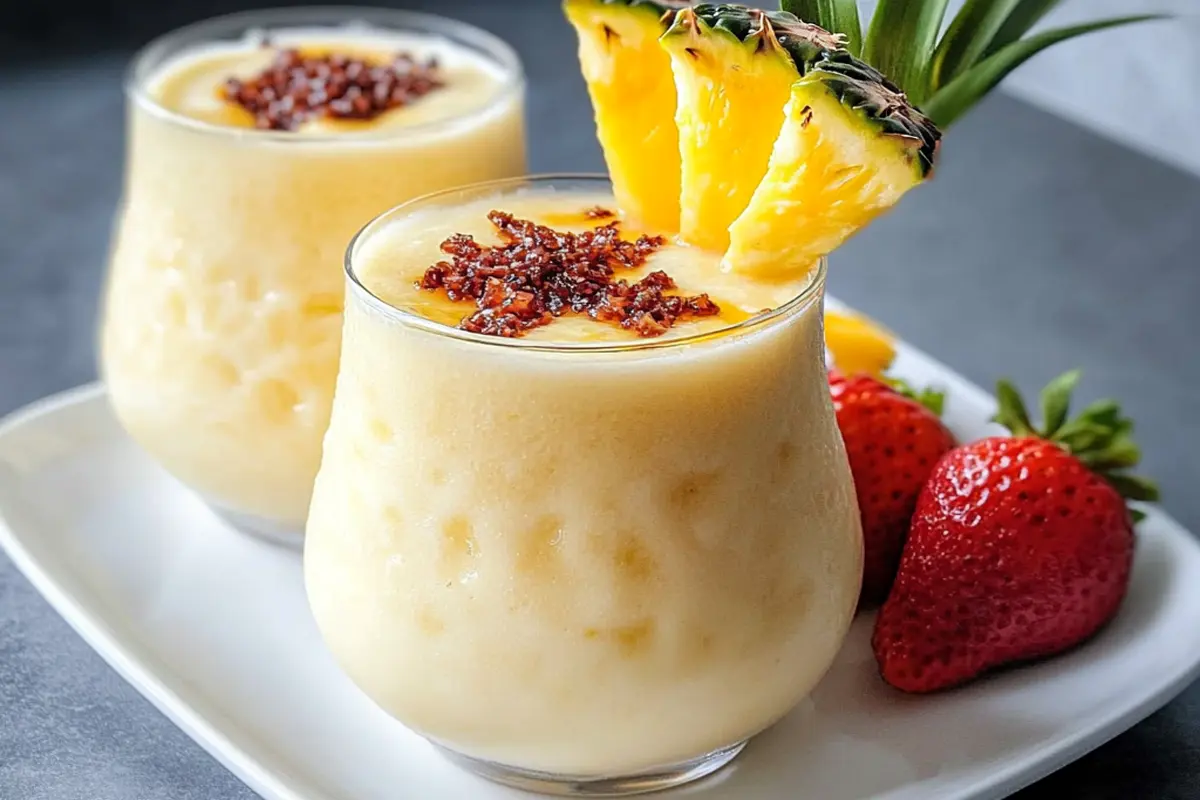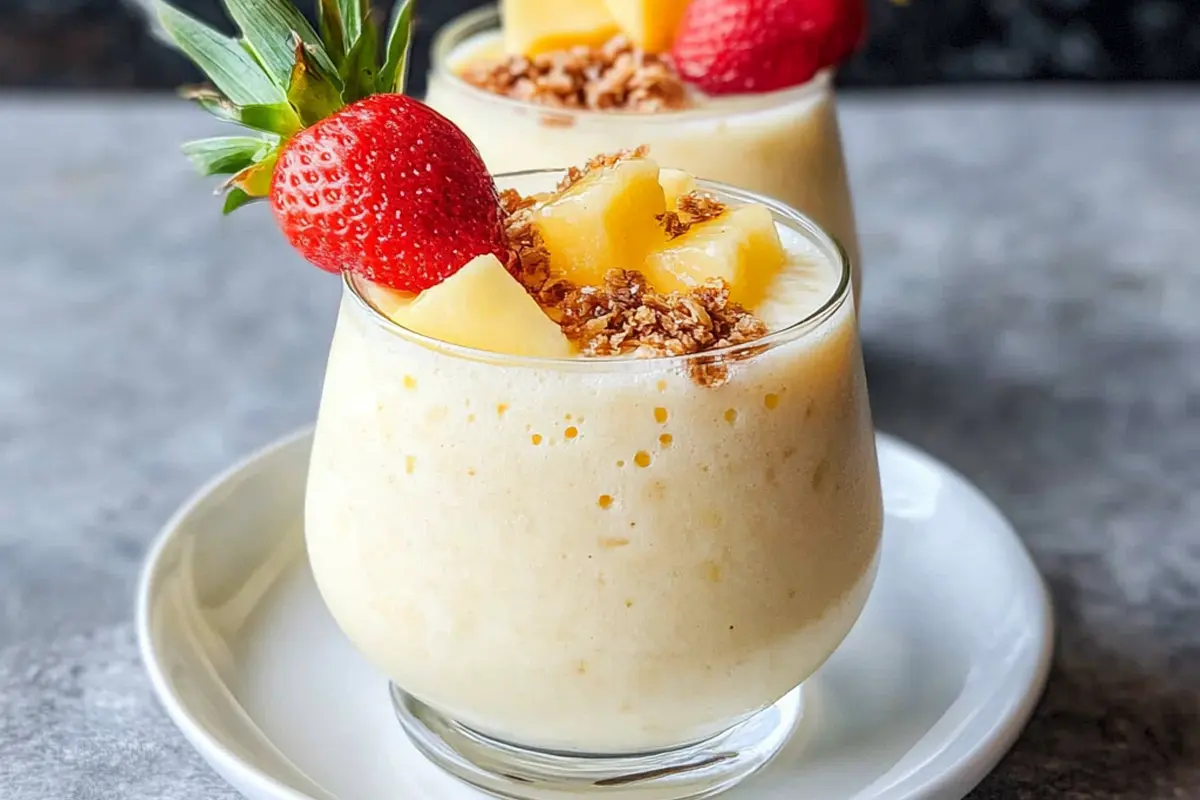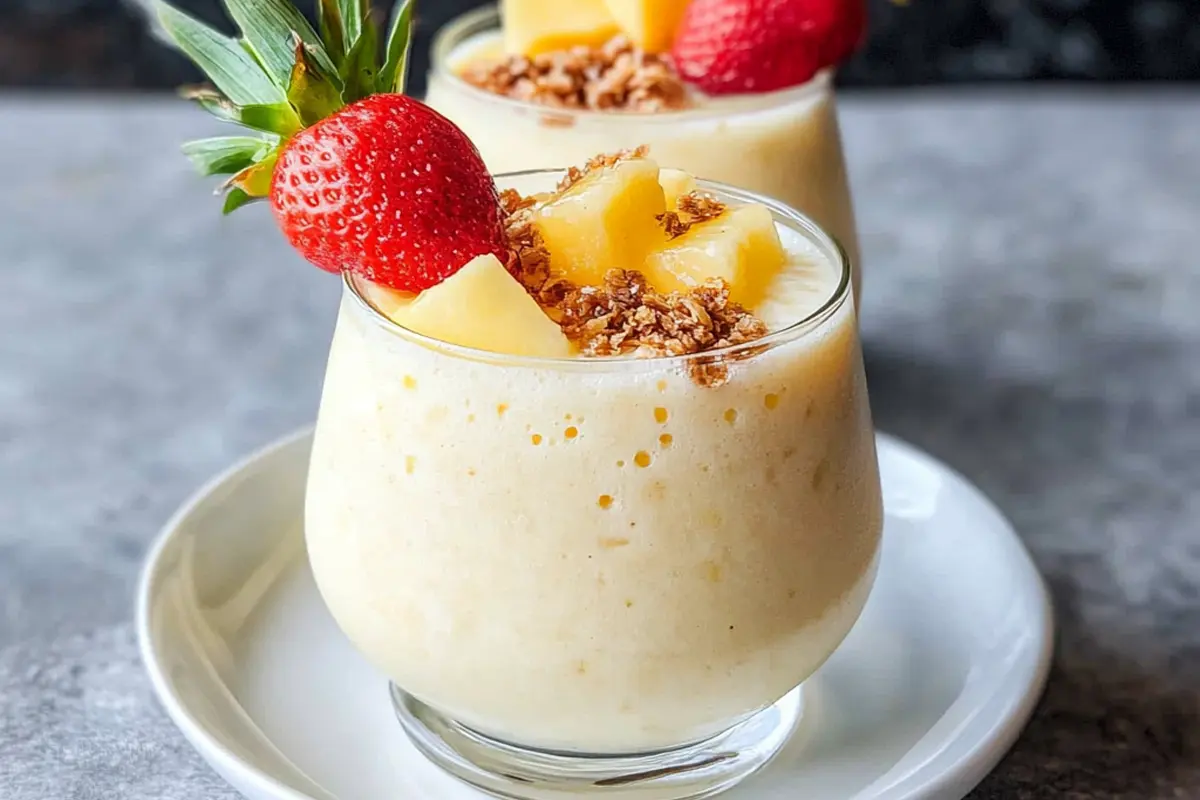Introduction: A Sip of Paradise
The Nonalcoholic Piña Colada is the perfect beverage for anyone seeking a tropical escape in a glass. Combining the creaminess of coconut, the zing of pineapple, and the chill of crushed ice, this drink has a universal appeal that transcends age, culture, and occasion. Whether it’s a sunny beach day, a family gathering, or a festive party, the Nonalcoholic Piña Colada is a delightful addition to any menu.
This guide will take you on a deep dive into the world of this tropical delight. We’ll explore its rich history, the art of crafting the perfect blend, creative variations, pairing ideas, and much more. Prepare to master the art of the Nonalcoholic Piña Colada and become the go-to host for all things tropical!
1. A Tropical Icon: The History of Piña Colada
The origins of the Piña Colada trace back to the lush shores of Puerto Rico in the mid-20th century. Bartenders in this tropical paradise experimented with local ingredients—rum, fresh pineapple, and coconut—to create a drink that captured the essence of the Caribbean. The name “Piña Colada,” which means “strained pineapple” in Spanish, reflects the central role of pineapple juice in the recipe.
By the 1970s, the Piña Colada had become a global phenomenon and was named Puerto Rico’s official national drink. Its creamy texture and sweet, fruity flavor made it a hit across cultures, solidifying its status as a symbol of tropical relaxation.
The Nonalcoholic Piña Colada, affectionately called the “Virgin Piña Colada,” emerged as a more inclusive version of the classic. It eliminated the rum while preserving the essence of the original, making it suitable for kids, non-drinkers, and health-conscious individuals.

2. Why Nonalcoholic Piña Coladas Are the Perfect Choice
The Nonalcoholic Piña Colada has gained immense popularity due to its versatility, inclusivity, and health benefits. Let’s explore why it’s the ideal drink for every occasion:
1. Family-Friendly
The alcohol-free version allows everyone, from kids to adults, to enjoy the tropical flavors.
2. Healthier Alternative
Without the rum, it’s a lower-calorie option that doesn’t compromise on taste.
3. Versatile Pairings
This drink pairs beautifully with a variety of cuisines, from grilled seafood to tropical desserts.
4. Refreshing and Energizing
The natural sweetness of pineapple juice and the creamy texture of coconut create a refreshing, energizing beverage.
3. The Core Ingredients of Nonalcoholic Piña Colada
1. Pineapple Juice
The heart of the drink, pineapple juice brings a tangy sweetness that defines the Piña Colada. Freshly juiced pineapples offer the best flavor, but high-quality bottled juice is a great alternative.
2. Coconut Cream
This thick, rich ingredient gives the Piña Colada its signature creaminess. Choose full-fat coconut cream for the best results.
3. Ice
Crushed ice is essential for achieving a smooth, slushy texture.
4. Sweeteners (Optional)
Depending on the sweetness of your pineapple juice, you might add honey, sugar, or agave syrup.
5. Garnishes
Pineapple wedges, maraschino cherries, and edible flowers elevate the drink’s presentation.
4. The Ultimate Recipe: Step-by-Step Guide
Ingredients
- 2 cups pineapple juice
- 1 cup coconut cream
- 1 cup crushed ice
- Optional: 1 tablespoon honey or sugar
Instructions
- Combine Ingredients: Add pineapple juice, coconut cream, and ice to a blender.
- Blend Until Smooth: Blend on high for 1-2 minutes until the mixture is creamy.
- Taste and Adjust: Add sweeteners if desired.
- Serve: Pour into a chilled glass and garnish with pineapple wedges and cherries.
5. Nutritional Benefits: A Healthy Indulgence
The Nonalcoholic Piña Colada is not just a treat for your taste buds—it can also offer health benefits:
- Vitamin C: Pineapple juice boosts immunity and fights oxidative stress.
- Healthy Fats: Coconut cream contains medium-chain triglycerides (MCTs), which may support metabolism.
- Hydration: A blend of coconut and pineapple provides natural electrolytes.
6. Creative Variations for Every Palate
The classic recipe is a masterpiece, but there’s room to experiment. Here are some fun variations:
1. Tropical Berry Blast
Blend strawberries or raspberries with the base ingredients for a fruity twist.
2. Mango Colada
Add fresh or frozen mango chunks for a richer tropical flavor.
3. Lime and Coconut
Add lime juice and zest for a zesty upgrade.
4. Protein Boost
Blend in a scoop of vanilla protein powder for a post-workout treat.
7. Perfect Pairings: Food That Complements Your Mocktail
Enhance your Piña Colada experience with complementary dishes:
- Sweet Hawaiian Crockpot Chicken
- Coconut shrimp with a tangy dipping sauce.
- Tropical fruit salads featuring mangoes, kiwis, and dragon fruit.
- The Complete Guide to Baking the Perfect Pineapple Upside-Down Cake
8. Serving Suggestions for Different Occasions
The versatility of Nonalcoholic Piña Coladas makes them suitable for a wide range of events:
1. Pool Parties
Serve in hollowed-out pineapples with colorful straws for a festive vibe.
2. Weddings
Offer as a signature mocktail in elegant glasses.
3. Kids’ Parties
Create a DIY Piña Colada bar where kids can add their favorite toppings.

9. The Art of Presentation: Making Your Drink Look Stunning
A well-presented drink is a feast for the eyes. Here are some tips:
- Use Decorative Glasses: Opt for hurricane or tiki glasses.
- Add Layers: Create a layered effect by blending ingredients separately.
- Garnish Generously: Fresh fruit, mint leaves, and edible flowers make the drink Instagram-worthy.
10. Sustainability in Your Glass: Eco-Friendly Garnishes
Consider these sustainable alternatives to traditional garnishes:
- Reusable Straws: Opt for bamboo, stainless steel, or silicone.
- Edible Garnishes: Use pineapple wedges, cherries, or herbs that guests can eat.
- Compostable Cups: Perfect for outdoor events.
11. The Rise of Mocktails: Cultural Trends and Shifts
Mocktails like the Nonalcoholic Piña Colada are redefining social drinking. As people prioritize wellness and inclusivity, these alcohol-free beverages are taking center stage at events and in bars.
12. How to Troubleshoot Common Piña Colada Issues
1. Too Watery
- Reduce the amount of ice or use frozen fruit.
2. Overly Sweet
- Balance the sweetness with a splash of lime juice.
3. Not Creamy Enough
- Use full-fat coconut cream for a thicker consistency.
13. Hosting a Tropical Party: Complete Guide
Decor
Use tiki torches, palm leaves, and seashells for an authentic tropical atmosphere.
Activities
Plan games like limbo or hula hoop contests.
Menu
Serve dishes like coconut rice, grilled pineapple, and seafood skewers.
14. Advanced Tips for Perfecting the Nonalcoholic Piña Colada
- Infuse Flavors: Steep fresh mint leaves in coconut cream for added depth.
- Experiment with Texture: Add a small scoop of vanilla ice cream for a milkshake-like consistency.
- Use Fresh Ingredients: Freshly juiced pineapple always beats canned alternatives.
15. FAQs: Everything You Need to Know
Can I Make Nonalcoholic Piña Colada Ahead of Time?
Yes, you can prepare it in advance. However, to maintain the best texture and flavor:
- Store the mixture in an airtight container in the refrigerator.
- Re-blend the drink before serving to restore its creamy consistency.
Can I Use Coconut Milk Instead of Coconut Cream?
Yes, but note that coconut milk is thinner and less creamy than coconut cream. If you’re using coconut milk, the drink will have a lighter texture, which might be ideal if you prefer a less rich version.
Is Nonalcoholic Piña Colada Vegan?
Yes! The standard recipe is vegan-friendly, provided you use a plant-based sweetener like agave syrup instead of honey. Always check your coconut cream to ensure it’s free of animal-derived ingredients.
What’s the Difference Between Coconut Cream and Coconut Milk?
- Coconut Cream: Thicker and richer, ideal for creamy drinks like Piña Coladas.
- Coconut Milk: Thinner and lighter, often used for cooking or lighter beverages.
For the best Piña Colada, coconut cream is the recommended choice.
Can I Use Frozen Pineapple Instead of Juice?
Absolutely! Blending frozen pineapple chunks creates a thicker, more slushy consistency. It’s a great way to intensify the pineapple flavor while eliminating the need for ice.
What’s the Best Garnish for a Nonalcoholic Piña Colada?
Classic garnishes include:
- A slice of fresh pineapple.
- A maraschino cherry.
- An umbrella or colorful straw for flair.
For a modern twist, try edible flowers or a sprinkle of toasted coconut.
How Can I Make a Sugar-Free Version?
To create a sugar-free Nonalcoholic Piña Colada:
- Use unsweetened pineapple juice.
- Skip added sweeteners like sugar or honey.
- Add natural sweetness with fruits like mango or banana.
Can I Serve It Warm During Winter?
While uncommon, you can serve a warm version of the Nonalcoholic Piña Colada by:
- Gently heating the pineapple juice and coconut cream.
- Blending as usual but skipping the ice.
Add warm spices like cinnamon or nutmeg for a festive touch.
How Can I Make It Thicker?
To achieve a thicker consistency:
- Use frozen pineapple chunks instead of juice.
- Add a scoop of vanilla ice cream.
- Reduce the amount of liquid in the recipe.
What Are Some Creative Variations?
Here are a few creative takes on the classic:
- Berry Piña Colada: Blend in strawberries or raspberries.
- Lime Coconut Piña Colada: Add lime juice and zest for a zesty twist.
- Green Smoothie Piña Colada: Mix in spinach or kale for a nutrient boost.
Is It Safe for Pregnant Women?
Yes, Nonalcoholic Piña Coladas are safe for pregnant women. The drink is alcohol-free and rich in Vitamin C, but always consult with a healthcare provider if you have dietary concerns.
Can I Use Canned Pineapple Juice?
Yes, canned pineapple juice works well, but fresh pineapple juice offers a brighter, more natural flavor. If using canned juice, opt for unsweetened varieties.
How Can I Customize It for a Party?
For a party-friendly version:
- Set up a DIY Piña Colada station with different add-ins like berries, mango, or mint.
- Offer garnishes like toasted coconut, lime wedges, and colorful straws.
- Serve in themed glasses or hollowed-out pineapples for visual appeal.
Does Nonalcoholic Piña Colada Contain Dairy?
No, the drink is naturally dairy-free as it uses coconut cream, making it suitable for those with lactose intolerance.
How Many Calories Does It Have?
An 8-ounce serving of Nonalcoholic Piña Colada typically contains 180-200 calories. You can reduce the calorie count by:
Skipping added sweeteners.
Using light coconut milk instead of cream.
16. Final Thoughts: Bringing Tropical Bliss to Every Occasion
The Nonalcoholic Piña Colada is more than a drink—it’s a celebration of tropical flavors, inclusivity, and creativity. With endless customization options and universal appeal, this beverage is the ultimate addition to any event.
PrintNonalcoholic Piña Colada
Description
A nonalcoholic piña colada (also called a virgin piña colada) is a refreshing tropical drink made without rum. It’s creamy, sweet, and packed with coconut and pineapple flavors. Here’s how to make it:
Ingredients
- 2 cups frozen pineapple chunks
- 1 cup pineapple juice
- 1 cup coconut milk (or coconut cream for a richer texture)
- 1–2 tablespoons honey or sugar (optional, for extra sweetness)
- 1 cup ice cubes
Instructions
- Add all ingredients to a blender.
- Blend until smooth and creamy. If too thick, add more pineapple juice; if too thin, add more ice.
- Pour into glasses and garnish with a pineapple slice and a maraschino cherry.
- Serve with a straw and enjoy!

